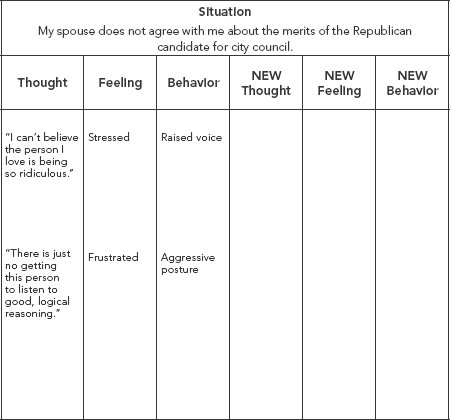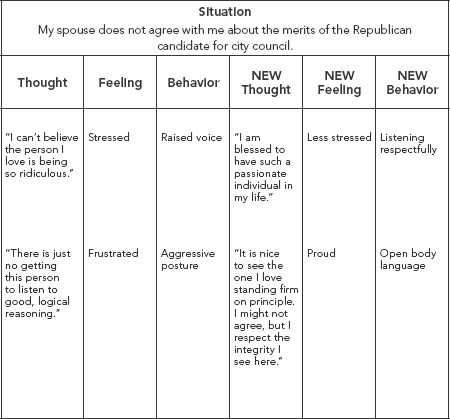

CHALLENGE YOUR
STRESS-INDUCING THOUGHTS
I HOPE YOU HAVE had some success logging your thoughts and feelings. Remember, your journey to a less-stressed life is just starting, and much of what you are discovering has a fairly steep learning curve. Expect that it will be difficult to clue in to your thoughts and feelings initially, but if you stick with it, you will become much more aware of your internal experience. My hunch is that you will be surprised by how negative and stress-inducing your thoughts actually are.
At this point you’re probably wondering, “What now? Now that I am becoming more aware of how my thoughts are causing the stress response in my body, what do I do about it?” Good question. When you identify a stress-inducing thought soon after encountering a stressful situation, you are in a great position to challenge the thought and then change it.
Let’s look at an example that will illustrate how to do this. Let’s say you are talking with your spouse about politics. You are a staunch Republican, and your spouse has been “leaning left” since you were married. Although you may not have talked much about politics while you were dating, it has been a point of contention for some time now. During this conversation you try to convey the importance of voting for the Republican candidate for city council.
Although your spouse has listened to your arguments intently, he or she is still convinced the best choice is the Independent candidate. About five minutes into the conversation, you realize your heart rate is up, you are sweating more than usual, and you are feeling quite stressed by your spouse’s inability to see your point of view. Your thoughts are centered on how “ridiculous” your spouse’s views are and on how difficult it is to communicate with someone so closed-minded. Your behavior is increasingly hostile and aggressive. I’ve summarized what we know so far about your stress process in this stress log.

With this information about your internal experience, you are in a position to begin challenging the thoughts that are producing your stress. In order to do this, you need to ask yourself a simple question: “Is there another way to look at this situation?” This one question can have a tremendous impact upon your stress level almost immediately because it opens you up to other possible perspectives on the situation. Basically, by asking this question you are communicating to yourself, in no uncertain terms, that the stress-producing thought is not working very well for you. It might be a valid perspective, but if it is creating stress, that line of thinking must go.
It’s important to note that I am not asking you to consider unrealistic ways to think about the situation, but to consider other, equally valid ways to understand what is happening to you at that moment. Let’s go back to our example and practice a little bit. Is there another way to think about a spouse who is not open to your arguments about the Republican candidate for city council?
What could you tell yourself in this situation that would be less stress inducing?

Rather than “ridiculous,” perhaps another way to define your spouse’s behavior is “passionate.” Maybe another way to think about your spouse’s “closed-mindedness” is to define that trait as “principled.” And did your spouse really refuse to listen to you, or did he or she listen objectively and then form an independent conclusion? How are you going to feel if you choose to believe the equally valid view that your spouse is passionate and principled rather than ridiculous and closed-minded? Without a doubt you will feel less stressed. Let’s look at the stress log to see how the new thoughts will affect your feelings and behavior.

I know this entire process might seem like a stretch to you because everyone knows how challenging it is to change a long-standing pattern, especially a long-standing thought pattern. However, it is possible. You will find that as you begin to argue with yourself and challenge your stress-inducing thoughts, you will truly feel less stressed. It’s a difficult process, no doubt, but it is extremely effective.
You are now ready to begin filling out your stress log completely. As stressful situations arise, start diffusing them by taking the time to assess your thoughts, feelings, and behavior, and then to write them down. Then begin to ask yourself the important question, “Is there another way to look at this situation?” Don’t be afraid to be creative and write down any other thoughts that might produce less stress. Think about the feelings and behavior that will emerge if you can let the new thoughts saturate your mind, then write them down.
Although there is no guarantee that you will be able to quickly adjust your thinking in the middle of your stress process, at least you’ll be paying attention to your internal experience. For the next few days you will be exposed to even more information about the source of your stress-producing thoughts. Armed with this new information, you will be able to “switch gears” more readily.
Because the stress log is obviously one of the foundations of this program, I want you to focus on filling it out every day for the rest of this program. Continue to log your thoughts and feelings at least three times a day, no matter what. Even as you see the program working and you begin to feel less stressed, keep logging your thoughts and feelings.
In addition to the three built-in log entries (between breakfast and lunch, lunch and dinner, and dinner and bedtime), complete all seven columns of the stress log every time you notice that you are starting to feel stressed. Again, you might not be able to break out of your stress immediately, but you will be growing more aware of the connection between your thoughts, feelings, and behavior.
ASSIGNMENT
• Practice passive or active relaxation for twenty minutes.
• Log thoughts, feelings, and behavior three times a day after breakfast, after lunch, and before bedtime using the stress log.
• Complete all seven columns of the stress log when you begin to feel stressed.
STRESS LOG
This stress log will help you practice becoming more aware of the emotions you experience when your stress begins. It should be completed daily beginning on Day Six of the Stress Relief for Life program. If you encounter a stressful experience during your day, fill out the entire row under the appropriate time period. If you don’t have a stressful experience, complete only the first four columns.
